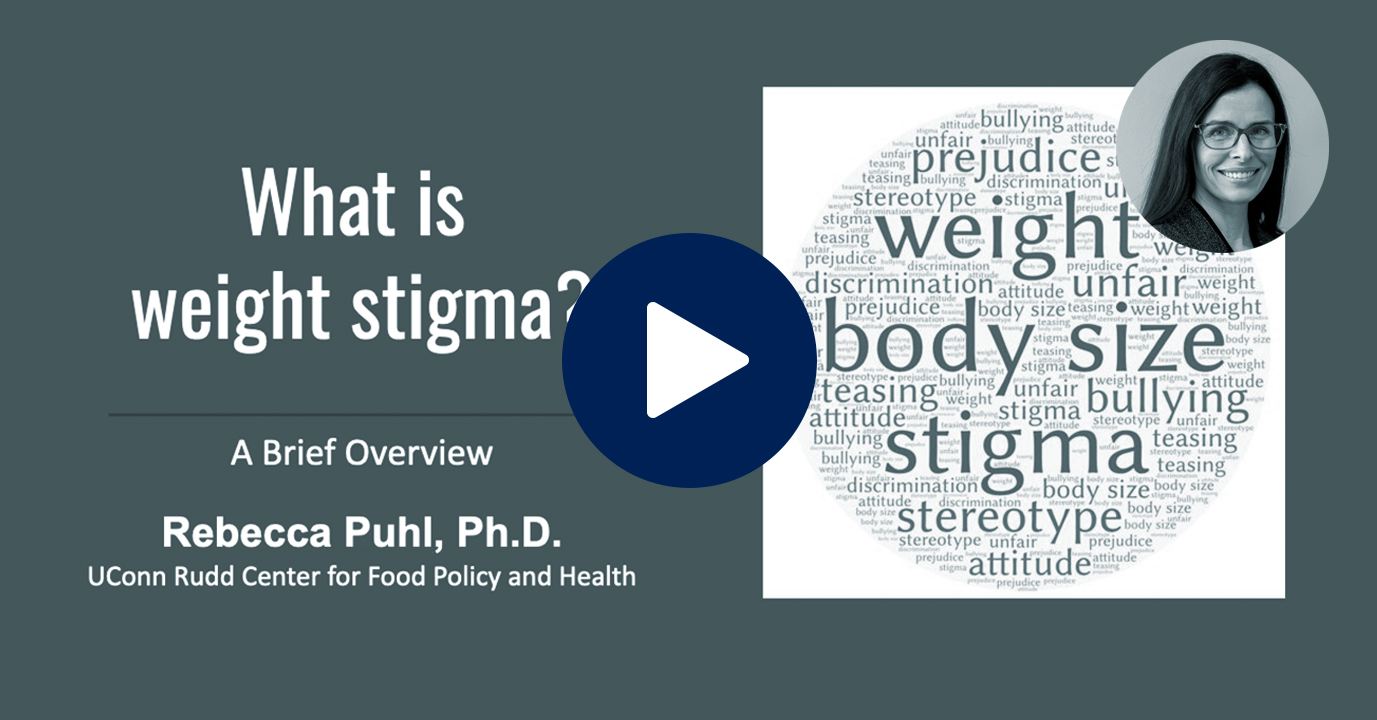 Obesity is complex
Obesity is complexMany contributing factors are outside of an individual’s control.
 Weight stigma negatively impacts health
Weight stigma negatively impacts healthExperiencing weight stigma has consequences for psychological well-being and weight-related health.
 Professor Rebecca Puhl:
Professor Rebecca Puhl:
An expert on weight biasIt is important to understand how and why weight stigma affects healthcare.
Welcome to Supportive Obesity Care
Obesity occurs in over 40% of US adults and is recognized as chronic with a complex etiology.1 Our society can be hostile toward people with high weight, who commonly face judgment, prejudice, and unfair treatment in their daily lives, including the healthcare setting.2 Weight stigma is harmful to health and well-being3,4 and creates barriers to effective patient care.5-8
While society often assumes people to be personally responsible for their weight, research indicates that body weight is determined by multiple factors, many that are outside of an individual’s control.9,10 Healthcare professionals often find it difficult to broach the topics of weight and weight management with patients. Optimal patient care requires an understanding and awareness of weight stigma, its impact on health, and the strategies necessary to reduce bias.8
The topics on this website range from the pathophysiology of obesity to how to have supportive conversations with patients about weight, offering practical knowledge and strategies that are applicable in everyday clinical practice. The goal is simple: to equip healthcare professionals with knowledge and tools to provide more respectful, supportive, and compassionate care to patients of all body sizes.
Learner Journey Overview

Weight stigma is harmful and long-lasting, contributing to emotional distress, poor physical health, and reduced quality of life.8
This problem extends to the healthcare setting, where weight bias is present and creates barriers to effective patient care.
What is weight stigma?
An explanation of weight stigma, where it comes from, and how it can be recognized.
Weight stigma in healthcare
A summary of weight stigma in healthcare and how this creates barriers for effective patient care.
How can we improve healthcare for people of all body sizes?
Professor Puhl highlights strategies for providing supportive care of people with diverse body sizes.
Obesity is a chronic, relapsing, and progressive disease driven by the interaction of multiple factors beyond food intake and physical activity, many of which are beyond an individual’s control. These include biologic factors, genetic factors, environmental influences, and social determinants of health.9 The heritability of body weight has been estimated at 40–77%.10 ,11
Introduction to Supportive Obesity Care
Professor Puhl provides a brief overview of topics covered on this website.
References for individual resources can be found in the Resource Center.
1. Ogden CL, Fryar CD, Martin CB, Freedman DS, Carroll MD, Gu Q, Hales CM. Trends in Obesity Prevalence by Race and Hispanic Origin-1999-2000 to 2017-2018. JAMA. 2020 Sep 22;324(12):1208-1210. doi: 10.1001/jama.2020.14590.
2. Pearl RL. Weight bias and stigma: Public health implications and structural solutions. Soc. Iss. Policy Rev. 2018. 12:146-182. https://doi.org/10.1111/sipr.12043
3. Zhu, X., Smith, R. A., & Buteau, E. (2022). A meta-analysis of weight stigma and health behaviors. Stigma and Health, 7(1), 1–13. https://doi.org/10.1037/sah0000352
4. Alimoradi Z, Golboni F, Griffiths MD, Broström A, Lin CY, Pakpour AH. Weight-related stigma and psychological distress: A systematic review and meta-analysis. Clin Nutr. 2020 Jul;39(7):2001-2013. doi: 10.1016/j.clnu.2019.10.016.
5. Phelan SM, Burgess DJ, Yeazel MW, Hellerstedt WL, Griffin JM, van Ryn M. Impact of weight bias and stigma on quality of care and outcomes for patients with obesity. Obes Rev. 2015 Apr;16(4):319-26. doi: 10.1111/obr.12266.
6. Alberga AS, Edache IY, Forhan M, Russell-Mayhew S. Weight bias and health care utilization: a scoping review. Prim Health Care Res Dev. 2019 Jul 22;20:e116. doi: 10.1017/S1463423619000227
7. Puhl RM, Lessard LM, Himmelstein MS, Foster GD. The roles of experienced and internalized weight stigma in healthcare experiences: Perspectives of adults engaged in weight management across six countries. PLoS One. 2021;16(6):e0251566. doi: 10.1371/journal.pone.0251566
8. Puhl RM. Weight Stigma and Barriers to Effective Obesity Care. Gastroenterol Clin North Am.2023;52(2):417-428. doi:10.1016/j.gtc.2023.02.002
9. Wharton S, Lau DCW, Vallis M, Sharma AM, Biertho L, Campbell-Scherer D, Adamo K, Alberga A, Bell R, Boulé N, Boyling E, Brown J, Calam B, Clarke C, Crowshoe L, Divalentino D, Forhan M, Freedhoff Y, Gagner M, Glazer S, Grand C, Green M, Hahn M, Hawa R, Henderson R, Hong D, Hung P, Janssen I, Jacklin K, Johnson-Stoklossa C, Kemp A, Kirk S, Kuk J, Langlois MF, Lear S, McInnes A, Macklin D, Naji L, Manjoo P, Morin MP, Nerenberg K, Patton I, Pedersen S, Pereira L, Piccinini-Vallis H, Poddar M, Poirier P, Prud'homme D, Salas XR, Rueda-Clausen C, Russell-Mayhew S, Shiau J, Sherifali D, Sieve piper J, Sock lingam S, Taylor V, Toth E, Twells L, Tytus R, Walji S, Walker L, Wicklum S. Obesity in adults: a clinical practice guideline. CMAJ. 2020 Aug 4;192(31):E875-E891. doi: 10.1503/cmaj.191707.
10. Westbury S, Oyebode O, van Rens T, Barber TM. Obesity Stigma: Causes, Consequences, and Potential Solutions. Curr Obes Rep. 2023 Mar;12(1):10-23. doi: 10.1007/s13679-023-00495-3.
11. Elks CE, den Hoed M, Zhao JH, Sharp SJ, Wareham NJ, Loos RJ, Ong KK. Variability in the heritability of body mass index: a systematic review and meta-regression. Front Endocrinol (Lausanne). 2012 Feb 28;3:29. doi: 10.3389/fendo.2012.00029. PMID: 22645519; PMCID: PMC3355836.
This website is for educational purposes only and includes resources to help healthcare professionals deliver supportive and compassionate patient care to people of diverse body sizes. The site does not contain information about any Lilly products and has no commercial intent.
Copyright © 2025 UConn Rudd Center. All rights reserved.
VV-MED-151325 © 2025 Lilly USA, LLC. All rights reserved.



